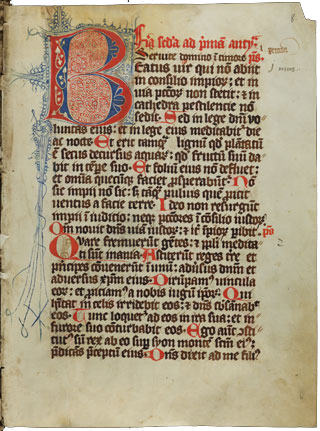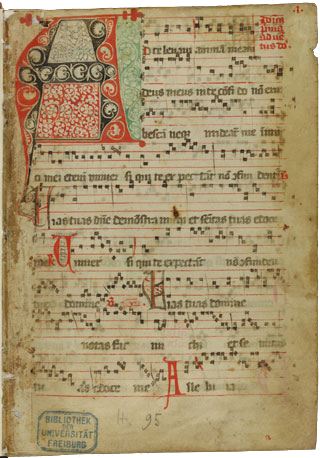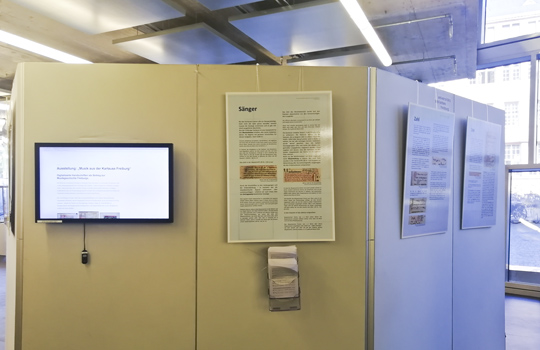Interplay between Music and Body
Freiburg, Jan 02, 2020
Bible passages in Latin and a medieval system of notation formed the basis for a seminar in which musicology students brought music from the past back to life. Under the instruction of Dr. Stefan Häussler, the students studied the manuscripts of chants written by the monks of Freiburg’s former Carthusian monastery. They then presented audio samples of their results at an exhibition.

The music of the Freiburg Charterhouse vanished long ago. We cannot say precisely what the medieval works once sounded like. Photo: Goffkein/stock.adobe.com
The music of the Freiburg Charterhouse vanished long ago. Although several manuscripts with musical notation have survived, we cannot say precisely what the medieval works once sounded like. All we can do is reimagine them. Visitors of the exhibition “Music in the Charterhouse” can listen to several examples at the Freiburg University Library. “They are approximations,” says Stefan Häussler, meaning that they are more musical interpretations than comprehensively verified reconstructions, because there are simply too many uncertain aspects.
Without Time und Tempo
The musicologist, who teaches at the University of Freiburg and is also a member of the Freiburg ensemble SurPlus, taught a seminar on the Carthusian chants last summer semester. The work he and his eight students did in the seminar led to an exhibition providing insight into a lost world by means of poster boards, audio samples, and a display case with literature and films. The fact that we don’t know for certain what the chants sounded like has to do with the medieval system of notation, explains Häussler. While it formed the basis for our five-line system and shares many parallels with it, it didn’t even include markings for time and tempo, among other things. Researchers suspect that there was a close relationship between the performance of the melody and the lyrics. The lyrics were written in Latin and consisted almost exclusively of Bible passages. “The use of the Latin language ensured that certain linguistic foundations remained intact over the course of more than a thousand years and could exert new influence on the performance again and again,” says Häussler, remarking that the seminar participants had to transcribe the notes before they could record the chants for the audio samples.

Bible passages in Latin: In the music of the Carthusian Order, there was a close relationship between the performance of the melody and the lyrics. Source: Psalterium – Freiburg University Library, Ms. 64, [Freiburg], [1366/1405 & before 1405]
Links between Monastery and University
The fact that evidence of the Carthusian Order in Freiburg, particularly of musical life in the charterhouse, can be found in the university library, is a result of the close links between the monastery and the university. An example of these links is Gregor Reisch, who first taught at the university and then became prior at the monastery around the year 1500. “A large part of the manuscripts written at that time are still in possession of the university library today,” says Häussler. This was the prerequisite for studying the music of the charterhouse in the seminar. “In digitizing the sources, the Freiburg University Library played a big part in unearthing these treasures.”
The topic of the seminar unites two of the musicologist’s main areas of interest: the history of music in Freiburg and manuscripts as evidence of the music of the past. “It’s not easy to get students interested in the world of the Middle Ages; you need to win them over to it,” says Häussler. “It was a challenge to design the course so that it was possible to deal with the different requirements.” In addition, a lot of work went into organizing the exhibition. Häussler assigned the topics early on, and the students worked both individually and in groups. Several students were responsible for writing texts for the exhibition. The texts then had to be edited and arranged in a layout, the images selected, the posters hung up, and the display case set up.

The medieval system of notation does not include markings for time and tempo. It is thus unknown how the chants really sounded. Source: Graduale – Freiburg University Library, Ms. 95, [[s. l.], [1405–1417]]
Strict Order in the Sources
Indeed, studying a topic like this demands far more than just musicological knowledge. Latin language skills are useful, as are auxiliary sciences of history and a feel for the great significance rules and a strict social order held for people’s lives in the Middle Ages. This was further intensified by the particular strictness of the Carthusian Order. The Carthusians spend their day in silence; practically the only time the monks speak freely is during their Sunday walk. It’s hard to overestimate how important music can be in a community of this kind. The strict order is also reflected in the manuscripts. The chants structured the monks’ daily routines and were bound to the liturgical year. The manuscripts include a note on when they were to be performed as well as details on the performance style, such as when the singer was to remove or put on his hood.
The Question of Polyphony
The music that once rang out from the Freiburg Charterhouse is representative of the entire order. It consists of monophonic chants, although the history of music in the late Middle Ages is marked by a shift to polyphony. Häussler is not surprised by this apparent contradiction: There are initially relatively few sources providing evidence of polyphony, says the musicologist, but later on there are such prominent examples as those of the Notre-Dame school, which gave the name to an entire period of music history. And indeed, it’s not out of the question that some chants were notated monophonically but performed polyphonically – transitional forms are perfectly conceivable, says Häussler, who earned his doctorate from the University of Freiburg in 2013 with a dissertation on polyphony in the eleventh century.

The students organized an exhibition providing insight into the lost musical world of the Freiburg Charterhouse by means of poster boards and audio samples. Photo: Yuefeng Xu
Modestly Bound Manuscripts
When one speaks of the music manuscripts of the Freiburg Charterhouse, what is meant above all is those intended for liturgical use, initially leaving aside others that the monks took with them to their cells to study. No lavishly decorated manuscripts have survived. Although Häussler doesn’t deny that such copies may have existed, manuscripts were generally bound into books in a rather modest fashion and were not intended for representative purposes. This may but doesn’t necessarily have something to do with the ascetic character of the order, says Häussler, pointing out that the parchment manuscripts do include elaborately designed initials and illustrations, such as a picture King David’s stringed instrument – even though the use of musical instruments was not allowed in the charterhouse.
Music Set the Pace of Life
From a modern point of view, it seems paradoxical that the liturgical manuscripts played a fixed role in the everyday life of the monastic community but that the monks did not actually use them for singing. Researchers suspect that they memorized the chants and used the manuscripts to prepare and reflect on their performance, for which purpose a particular monk was probably selected to serve as a kind of “cantor of the week.” The music as such set the pace of the monks’ lives: Some chants were sung daily, others weekly, and others still only during particular periods such as Lent. “I was also interested in emphasizing the strangeness of monastic life and the fascinating intertwining of music and body connected with it,” Häussler emphasizes. As limited as the music may seem, it encompassed religious experience in all its fullness and pervaded the entire being.
Annette Hoffmann

